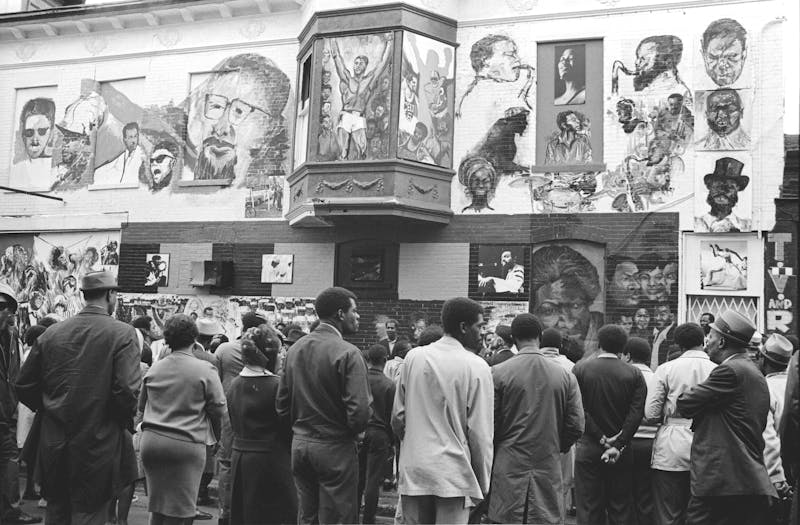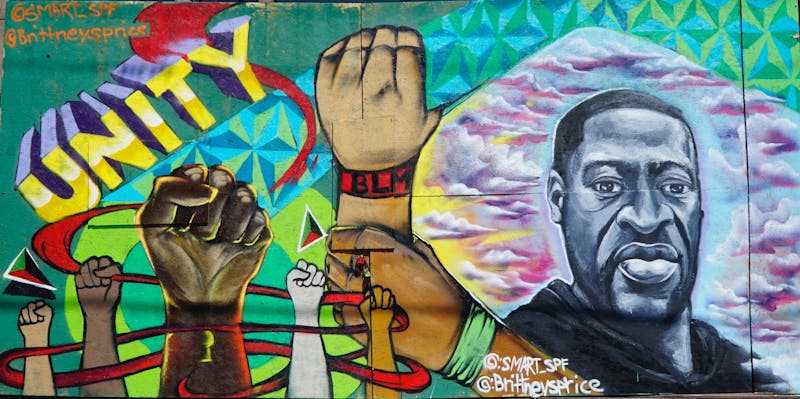On May 28, a group of artists got to work on the side of the Cup Foods grocery store, on the corner of 38th Street and Chicago Avenue South in Minneapolis. Three days earlier, George Floyd had been killed there by police officer Derek Chauvin. A mural now stands at the site: Floyd’s face is front and center, his name etched in big blocky yellow letters on either side. A sunflower blazes behind him like a fiery halo; in its center, the names of other victims of police brutality have been painted in white. The phrase “I can breathe now” is drawn across his chest, an inversion of what he could not do in the last moments of his life. People have left letters, stuffed animals, and flowers beneath the mural to pay their respects, turning it into a kind of shrine. During Floyd’s memorial, a digitized rendition of the mural served as the backdrop behind his casket. It’s one of the most recognizable images to have come out of the protests raging around the world.
As the protests proliferated, so did the murals. Portraits of Floyd have appeared on an Israeli separation wall in Bethlehem and on the last remains of a building damaged by air strikes in Idlib, Syria. Murals of Floyd spread as far as the news of his death. They do more than just garner likes on someone’s feed or catch the eye of passersby. These displays of public art have a long historical connection to civil rights movements in the United States and are an organic expression of the politics the latest movement has unleashed—a politics that is insistent, collaborative, and suspicious of institutions of all kinds.
The modern political mural has its origins in the 1920s, in Mexico. The post-revolutionary government commissioned the creation of murals in order to inspire nationalistic fervor. Artists like Diego Rivera, José Clemente Orozco, and David Alfaro Siquieros—los tres grandes—were hired to paint on public buildings across the country. Franklin Roosevelt’s Public Works Administration, which came out of the New Deal, was inspired by the Mexican muralist movement. The administration invited los tres grandes to paint murals in the U.S. and later hired American artists as part of an effort to stimulate the economy during the Great Depression. In introducing political murals into the American mainstream, FDR established them as a top-down art form emanating from the dominant authority. Often, artists would paint murals in neighborhoods they didn’t belong to, spending only a few weeks there to complete the assigned project.

The role of the mural changed during the civil rights movement. In the late 1960s, black people were in the midst of an identity crisis. “We had already lost Martin. Malcolm X died in ’65, and many African Americans artists and writers had turned away from mainstream society,” says University of Illinois professor Abul Alkalimat, the founding chair of the Organization of Black American Culture. “We were in search of a redefinition of the self: ‘Who are we?’” In 1967, OBAC members in Chicago had the answer: They painted a mural showcasing black identity, a bold affirmation of their rights and their lives under systemic oppression. The faces of Muhammad Ali, W.E.B. DuBois, and Harriet Tubman, among others, appeared on the side of a building at 43rd Street and Langley Avenue. The Wall of Respect is cited by scholars as the first true community mural in America; a declaration of resistance from the people rather than state-sponsored propaganda. It inspired a mural movement across the city, and in the years that followed, an additional 1,500 murals appeared in black neighborhoods in the rest of the U.S.
Although a mysterious fire in 1971 burned down the building that featured the Wall of Respect, its legacy was profound. As Dylan A. T. Milner writes, mural painting became a “tactic to reclaim colonized space.” Mexican-American artists used similar protest art during the Chicano art movement. The Berlin Wall was littered with art depicting rebellion until its fall in 1989, while over 2,000 murals were created in Belfast, Ireland, and Derry during The Troubles. Following the 2016 election of Donald Trump, Mexican artist Enrique Chiu and others painted a mural on the Mexican side of the U.S.-Mexico border, while pro-democracy Post-it notes were stuck to Lennon Walls in China during the 2019 Hong Kong protests.

It is no surprise, then, that murals have been the primary artistic response to the outrage over racism and police brutality in the U.S. “My art is a protest in itself,” California-based artist Brittney S. Price says of her Unity Wall, a mural on 315 East Eighth Street in downtown Los Angeles. “I’m linked to this community, I know the people here.” The mural, made in cooperation with fellow black artist Shakir Manners, is painted on the side of a building belonging to a black-owned business. It depicts Floyd in the clouds, alongside symbols of black power and resistance: raised fists, a Black Lives Matter bracelet. Price was almost arrested by police officers while painting the mural. “I told the cops I had the owner’s permission, I think they thought I was vandalizing,” she says. The response from the community has been overwhelmingly supportive.
There is a major difference between these murals and those that are being overseen by authorities. Though New York City Mayor Bill de Blasio has commissioned Black Lives Matter murals, he has also defended police’s violent actions against protesters, which makes his call for public art seem performative and perfunctory.

Washington, D.C., Mayor Muriel Bowser commissioned an enormous “Black Lives Matter” mural on a street near the White House, complete with a renamed Black Lives Matter Plaza, but has committed to expanding the city’s police force. When she enforced a curfew for protesters, she was sued by the D.C. chapter of Black Lives Matter. “[She] must be held accountable for the lip service she pays in making such a statement while she continues to intentionally underfund and cut services and programs that meet the basic survival needs of black people in D.C.,” the statement reads.
These municipally funded artworks represent just one of the many ways in which mainstream politicians have attempted to co-opt the Black Lives Matter movement, while failing to commit to genuine, radical change. (The city-sponsored mural is not unlike the spectacle of Democratic lawmakers kneeling in silence to commemorate Floyd’s death, wearing kente cloth.) The power of the protest mural comes not just from “bearing witness,” as so many Democratic politicians are content to do, but from being protests themselves—against police brutality and racial inequality, yes, but also against the very forces that would channel the energy of the protests into the same old ineffective vessels for reform. The artistic value of the protest mural, then, lies not only in the way it affects the viewer, in whatever emotions it might stir in her, but also in the political beliefs that animated its creation.
After all, the existence of these murals is rarely permanent. Other portraits of black victims to police brutality have been destroyed or removed in the years after they were made. When protesters passed through Bay Street in Staten Island to rail against Floyd’s murder, a mural of Eric Garner, created following his death in 2014 at the hands of police officer Daniel Pantaleo, was gone. In Long Beach, California, a mural of Floyd outside a hair salon was vandalized (though it was later restored by the artists). What endures is not always the work of art, but its message: the hope—the demand—that things will change.